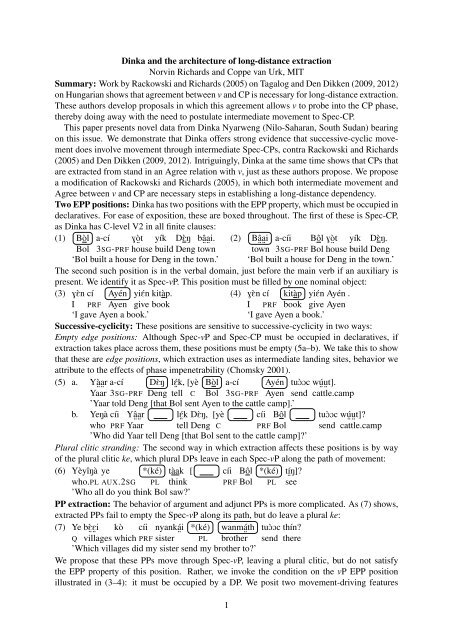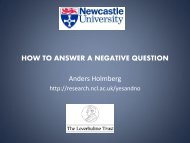Norvin Richards and Coppe van Urk (MIT): Dinka
Norvin Richards and Coppe van Urk (MIT): Dinka
Norvin Richards and Coppe van Urk (MIT): Dinka
You also want an ePaper? Increase the reach of your titles
YUMPU automatically turns print PDFs into web optimized ePapers that Google loves.
<strong>Dinka</strong> <strong>and</strong> the architecture of long-distance extraction<br />
<strong>Norvin</strong> <strong>Richards</strong> <strong>and</strong> <strong>Coppe</strong> <strong>van</strong> <strong>Urk</strong>, <strong>MIT</strong><br />
Summary: Work by Rackowski <strong>and</strong> <strong>Richards</strong> (2005) on Tagalog <strong>and</strong> Den Dikken (2009, 2012)<br />
on Hungarian shows that agreement between v <strong>and</strong> CP is necessary for long-distance extraction.<br />
These authors develop proposals in which this agreement allows v to probe into the CP phase,<br />
thereby doing away with the need to postulate intermediate movement to Spec-CP.<br />
This paper presents novel data from <strong>Dinka</strong> Nyarweng (Nilo-Saharan, South Sudan) bearing<br />
on this issue. We demonstrate that <strong>Dinka</strong> offers strong evidence that successive-cyclic movement<br />
does involve movement through intermediate Spec-CPs, contra Rackowski <strong>and</strong> <strong>Richards</strong><br />
(2005) <strong>and</strong> Den Dikken (2009, 2012). Intriguingly, <strong>Dinka</strong> at the same time shows that CPs that<br />
are extracted from st<strong>and</strong> in an Agree relation with v, just as these authors propose. We propose<br />
a modification of Rackowski <strong>and</strong> <strong>Richards</strong> (2005), in which both intermediate movement <strong>and</strong><br />
Agree between v <strong>and</strong> CP are necessary steps in establishing a long-distance dependency.<br />
Two EPP positions: <strong>Dinka</strong> has two positions with the EPP property, which must be occupied in<br />
declaratives. For ease of exposition, these are boxed throughout. The first of these is Spec-CP,<br />
as <strong>Dinka</strong> has C-level V2 in all finite clauses:<br />
(1) Bòl a-cí Gòt yík DÈN bâäi. (2) Bâäi a-cíi Bôl Gòt yík DÈN.<br />
Bol 3SG-PRF house ¨ build Deng town ¨ town ¨ 3SG-PRF Bol house ¨ build Deng<br />
‘Bol built a house for Deng in the town.’ ‘Bol built a house for Deng in the town.’<br />
The second such position is in the verbal domain, just before the main verb if an auxiliary is<br />
present. We identify it as Spec-vP. This position must be filled by one nominal object:<br />
(3) GÈn cí Ayén yiÉn kitàp.<br />
(4) GÈn cí kitàp yiÉn Ayén .<br />
I PRF Ayen give book<br />
I PRF book give Ayen<br />
‘I gave Ayen a book.’<br />
‘I gave Ayen a book.’<br />
Successive-cyclicity: These positions are sensitive to successive-cyclicity in two ways:<br />
Empty edge positions: Although Spec-vP <strong>and</strong> Spec-CP must be occupied in declaratives, if<br />
extraction takes place across them, these positions must be empty (5a–b). We take this to show<br />
that these are edge positions, which extraction uses as intermediate l<strong>and</strong>ing sites, behavior we<br />
attribute to the effects of phase impenetrability (Chomsky 2001).<br />
(5) a. Yàär a-cí DÈN lÉk, [yè Bòl a-cí Ayén tuÒOc wúüt]. Yaar ¨ 3SG-PRF Deng tell ¨ C Bol 3SG-PRF Ayen send cattle.camp ¨<br />
’Yaar told Deng [that Bol sent Ayen to the cattle camp].’<br />
b. YeNà cíi Yâär lÉk DÈN, [yè cíi Bôl tuÒOc wúüt]? who PRF Yaar ¨ tell ¨ Deng C PRF Bol send cattle.camp ¨<br />
’Who did Yaar tell Deng [that Bol sent to the cattle camp]?’<br />
Plural clitic str<strong>and</strong>ing: The second way in which extraction affects these positions is by way<br />
of the plural clitic ke, which plural DPs leave in each Spec-vP along the path of movement:<br />
(6) YèyîNà ye *(ké) tàak [ cíi Bôl *(ké) tíN]? who.PL AUX.2SG PL think PRF Bol PL see ¨<br />
’Who all do you think Bol saw?’<br />
PP extraction: The behavior of argument <strong>and</strong> adjunct PPs is more complicated. As (7) shows,<br />
extracted PPs fail to empty the Spec-vP along its path, but do leave a plural ke:<br />
(7) Ye bÈËi kò cíi nyankái *(ké) wanmáth tuÒOc thín?<br />
Q villages ¨ which PRF sister ¨ PL brother ¨ send there<br />
’Which villages did my sister send my brother to?’<br />
We propose that these PPs move through Spec-vP, leaving a plural clitic, but do not satisfy<br />
the EPP property of this position. Rather, we invoke the condition on the vP EPP position<br />
illustrated in (3–4): it must be occupied by a DP. We posit two movement-driving features<br />
1
on v, one associated with uϕ <strong>and</strong> the other with successive-cyclic movement. When a DP<br />
is wh-extracted, it satisfies both features, <strong>and</strong> the vP edge position is left empty, as in (5b);<br />
when a non-DP is wh-extracted, the two features must be satisfied by different specifiers, <strong>and</strong><br />
wh-movement fails to empty the vP edge position, as the example in (7) shows.<br />
A puzzle in long-distance extraction: PP extraction cannot satisfy the EPP property of the<br />
Spec-vP position in the clause the PP is generated in, as (7) shows. Long-distance extraction of<br />
PPs, however, does apparently satisfy EPP in Spec-vPs in higher clauses:<br />
(8) Yétenô cíi Yâär lÉk DÈN, [yè cíi Bôl Ayén tuÒOc]?<br />
where PRF Yaar ¨ tell ¨ Deng C PRF Bol Ayen send<br />
’Where did Yaar tell Deng [that Bol sent Ayen]?’<br />
The role of complement clauses: We propose that this difference arises because of the role<br />
the embedded CP plays in long-distance extraction. We first show that CPs in <strong>Dinka</strong> can also<br />
fill edge positions. When a verb takes a CP object, the vP <strong>and</strong> CP edges may be left empty:<br />
(9) a. Bòl a-cí DÈN lÉk [Ayén a-cí kitàp Gòoc].<br />
Bol 3SG-PRF Deng tell ¨ Ayen 3SG-PRF book buy<br />
’Bol told Deng [that Ayen bought a book].’<br />
b. Bòl a-cí<br />
lÉk DÈN [Ayén a-cí kitàp Gòoc].<br />
Bol 3SG-PRF tell ¨ Deng Ayen 3SG-PRF book buy<br />
c. a-cíi Bôl lÉk DÈN [Ayén a-cí kitàp Gòoc].<br />
3SG-PRF Bol tell ¨ Deng Ayen 3SG-PRF book buy<br />
d. * a-cíi Bôl DÈN lÉk [Ayén a-cí kitàp Gòoc].<br />
¨<br />
We take the wellformedness of (9b–c) to show that complement clauses may move to Spec-vP<br />
<strong>and</strong> Spec-CP, but must extrapose afterwards. The ungrammaticality of (9d) attests that Spec-<br />
CP is indeed occupied via movement; if Spec-CP is to be emptied by the complement clause,<br />
the complement clause must extract via Spec-vP, satisfying that EPP position also. These facts<br />
about clausal complementation suggest an explanation for the empty vP position in the matrix<br />
clause of (8); this position is occupied, not by the extracted phrase (which, as (7) shows, does<br />
not empty Spec-vP), but by the complement clause itself. The complement CP apparently must<br />
move to Spec-vP if extraction from it is to take place.<br />
Locality <strong>and</strong> phasehood: <strong>Dinka</strong> then also exhibits the restriction that Rackowski <strong>and</strong> <strong>Richards</strong><br />
(2005) <strong>and</strong> Den Dikken (2009, 2012) propose: extraction from CP requires v to Agree with CP<br />
(what is particular to <strong>Dinka</strong> is that this Agree relation triggers movement of CP to Spec-vP).<br />
We depart from these works (which predict, incorrectly for <strong>Dinka</strong>, that extraction takes place<br />
only via Spec-vP, <strong>and</strong> not via Spec-CP), however, in how we derive this requirement. We<br />
propose that Agree between v <strong>and</strong> CPs that are extracted from is necessary because such CPs<br />
act as interveners for wh-probing (as these CPs themselves carry a wh-feature, to attract the<br />
wh-phrase, Preminger 2011). This proposal is to be understood together with the principle,<br />
defended in Rackowski <strong>and</strong> <strong>Richards</strong> (2005), that once a Probe has Agreed with a Goal α, it<br />
is free to ignore α in further probing. This means that Agree between v <strong>and</strong> a complement CP<br />
allows v to ignore the CP as an intervener, letting v target the wh-phrase.<br />
In addition to this, we assume, following much work, that wh-extraction must take place via<br />
the edges of CP <strong>and</strong> vP, in order to escape the effects of phase impenetrability (e.g. Chomsky<br />
2001). The <strong>Dinka</strong> facts provide new support for this view, <strong>and</strong> also for the condition on extraction<br />
posited by Rackowski <strong>and</strong> <strong>Richards</strong> (2005); to escape a phase, not only must a wh-phrase<br />
move to the phase’s edge, but the phase must itself be Agreed with by the higher Probe that is<br />
responsible for moving the wh-phrase.<br />
Selected references: Dikken, M. den. 2012. On the strategies for forming long A’-dependencies.<br />
CUNY, Ms. - Rackowski, A. <strong>and</strong> N. <strong>Richards</strong>. 2005. Phase edge <strong>and</strong> extraction. LI.<br />
2



